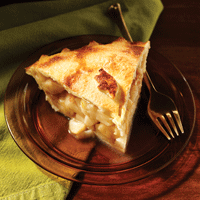Cutting into the numbers, segment by segment
Over the course of the past 18 months, Canadians have certainly had their fair share of pie. Unfortunately, that pie has been in chart form, usually explaining the latest in a calamitous series of economic forecasts and prognostications. However, while many of those estimations have proven to be guilty of pie-in-the-sky thinking, the restaurant industry has finally been handed some encouraging news.
While not universally positive, the figures revealed in the latest CREST report, from the NPD Group of Canada show the restaurant industry is trending upward, or at least stemming its losses. In fact, according to the company’s most recent update, consumer spending on foodservice in Canada rose by three per cent in the March to May 2010 quarter. However, that’s a surface view, and as usual, the story differs widely segment to segment, under that golden brown crust.
QSR | According to the NPD Group, the quick-service restaurant (QSR) segment remains the undisputed champion of the recession, and the quarters immediately following it. In fact, a recent release from the researchers stated, “Quick-service restaurants led the growth with increases in sales of popular food and beverage items — including breakfast sandwiches, hamburgers, sandwiches, hot coffee, soft drinks and bottled water — fuelled by targeted marketing support at a number of QSR chains.”
While it might be easy to pass off the success of QSRs as a function of people looking for less expensive food during a time of economic panic, Linda Strachan, restaurant industry analyst for the group, says it’s actually variety and innovation, not price, that have contributed most significantly to the success. “As the market slowly turns, it’s more important than ever for restaurant operators and foodservice manufacturers to present consumers with differentiated offerings,” she says. “Operators who stand apart on value, quality, convenience and other relevant attributes will successfully win more share than their competition.”
One QSR that has pushed the envelope on its product offering is A&W. Graduating from the teen burger to a whole slew of new menu items, including sirloin burgers and sliders, and from a suburban mainstay to announcing aggressive urban expansion plans, A&W is looking to hit all of the differentiators Strachan mentions.
“As a strategy-driven company we continue to build our relationship with our core baby-boomer customers, by focusing on the increasing demand for premium hamburgers like the Sirloin Uncle Burger and also accelerating the pace of growth of new restaurants,” says Paul Hollands, president and CEO of A&W Food Services of Canada Inc. “Despite continuing bumpy economic conditions, we’re pleased the A&W business demonstrated solid growth in the second quarter.”
The solid sales and growth figures for Q2, followed positive numbers for A&W in Q1 as well, when Hollands was equally optimistic. “During the first quarter, our advertising and promotions programs were particularly successful in building customer traffic and increasing sales. We’re very pleased with the same-store sales growth of 6.1 per cent despite what continues to be a challenging foodservice market environment,” he said at the time.
Family/Mid-scale | According to the overall national numbers, while in the past few quarters the full-service segment did not fare as well as its QSR counterpart, it does appear to be at least getting a tourniquet on its losses. In the second quarter of 2010, the NDP Group reports that full-service restaurant sales were down 0.3 per cent, which is far from a good news story; but it does mean the segment is recovering from its 2009 results, when sales were down by more than five per cent for the same quarter.
Breaking down the segment even further, operators of family/mid-scale restaurants were unique in another key stat: average check. According to the NDP Group, while the average check per person was down in all other market segments year-over-year, it was up 3.3 per cent in the family/mid-scale market.
The increase in average check doesn’t surprise Joel Friedman, senior vice-president of Franchising and Real Estate at Shoeless Joe’s, the Vaughan, Ont.-based chain of sports bars. “Our restaurants are busier, people are eating more and the average check is going up,” says Friedman. “People are still hesitating on the big purchases, and maybe cutting back on some dining out, but bars and restaurants can also be seen as a means of inexpensive entertainment: a place to gather and watch the hockey game with friends instead of buying tickets. Plus, business people are back on the road, which is great for us,” he adds.
However, according to Friedman, the bump in average check value hasn’t come about by accident, or even by virtue of an improving business climate. He says restaurants in the segment, and Shoeless Joe’s, by way of example, stepped up culinary programs. “We change our food every year, because people’s tastebuds are smarter now,” he says. “The days of being able to run a sports bar with a beverage program are over. And, you can’t just have a deep fryer in the back either. You have to serve food that’s high quality, authentic, and has tremendous value,” he adds.
To that end, the company has made some significant tweaks to what used to be a tailgate party menu. The calamari is breaded in panko crumbs, there’s a lobster, crab and shrimp dip, bison sliders, and the beef is certified Angus. “Sure we could get cheaper in terms of food cost, but it wouldn’t help us. You actually have to make great food now,” says Friedman. “And, even though there are some who say that we’re not out of the woods yet in terms of the economy, you’re going to see that the mid-scale/family market does very well in 2010 and 2011.”
Casual Upscale | Casual upscale has always been a difficult segment to define. It cuts a vast swath of the restaurant landscape from huge national chains to small independents. And, according to the NPD Group research, the overall numbers were uninspiring, with casual dining down 1.2 per cent year-over-year.
However, given the segment is huge, a one per cent decline overall means many players in this particular sandbox are faring well throughout the current year, and one of those is the Joey Restaurant Group.
“This year was a lot better than the last,” says Chris Mills, corporate executive chef for the Vancouver-based group. “We were flat in 2009, and that was almost exciting to be so strong. Our sales are up this year, and we’re happy with that performance.”
When it comes to finding success in an admittedly difficult marketplace, Mills is steadfast in terms of product offering, but notes it has forced the group to look at the menu carefully. “In terms of strategy, we changed nothing, but what we did do, was double down on what we presented the customer, in terms of service and value. In tough times, value is king.”
Though an upscale casual menu that features items like Baja fish tacos, lobster grilled cheese and a Panang prawn curry bowl might seem uncompromising, Mills says it’s precisely the kind of menu that allows him to provide the vital value component.
“In a way, we’re uniquely qualified in terms of where we sit in the market segment, to create value in our menu,” he says. “I buy the same food as everyone else, for basically the same price, so it comes down to technique. You can make things very complicated, with all sorts of specialty ingredients that really add to the cost, or you can make something with complex flavours simply, and I think we do just that.”
Fine Dining | As the whipping boy of the foodservice industry over the last two years, no one will be happier to see the recession fade quite like those in the fine-dining segment.
While the NPD Group numbers indicate the average check in the segment continues to fall, off 1.3 per cent year-over-year, the good news is that traffic is up significantly. Perhaps suffering from some pent-up haute-cuisine demand, diners rushed back into their favourite fine restos in 2010, with the segment experiencing a 5.7 per cent jump over 2009.
At Oliver & Bonacini, the venerable Toronto-based restaurant group that boasts culinary touchstones like Canoe, Auberge du Pommier and Biff’s Bistro, the group’s manager of operations, Jerrett Young, says the research jives well with what he sees on a day-to-day basis. “Take our four fine-dining concepts, and overall the average check is looking very consistent, but the level of business has steadily increased, particularly over the last six months,” he says. “Guests are still cautiously optimistic about the economy, but that can bode well for us in the marketplace.”
According to Young, the price point of fine dining, particularly in a trying economy, can leave patrons wary of experimentation, as they opt instead for what they see as a sure bet for their dining dollars. “Guests gravitate towards establishments they know will meet their expectations and have an established reputation of providing an experience that exceeds fine dining. We have that with Auberge and Canoe, and I’m sure other restaurants in the city that have built that sort of reputation have experienced the same,” he adds.
As the Canadian economy lumbers back to life, the dark clouds of 2009 showed the first signs of clearing in 2010. While not completely broken yet — average check prices continue to fall, and some segments are still in the red, year-over-year — the indicators have at least turned positive. However, those looking forward to going back to business as usual are in for a rude awakening. Thanks to the recession, many restaurants and restaurant groups now have stronger menus and offer their guests greater value than ever before. The lines between the segments are even more blurred, and competition for dining dollars is bound to be fierce.
Photography by Margaret Mulligan





















